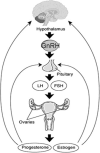The menstrual cycle: a biological marker of general health in adolescents
- PMID: 18574207
- PMCID: PMC2755071
- DOI: 10.1196/annals.1429.040
The menstrual cycle: a biological marker of general health in adolescents
Abstract
Menstruation is the cyclic, orderly sloughing of the uterine lining on account of the interactions of hormones produced by the hypothalamus, pituitary, and ovaries. There is a tendency among parents and clinicians to view oligo-amenorrhea as a normal variant in the teen years. In fact, the 95th percentile for the time interval between cycles is 90 days. Thus, it is abnormal for an adolescent to be amenorrheic for greater than 3 months, even in the early gynecologic years. Identification of abnormal menstrual patterns throughout adolescence may permit early identification of potential health concerns for adulthood. Few problems in gynecologic endocrinology are as complex or challenging to the clinician as amenorrhea. However, thorough evaluation of menstrual cycle disorders in adolescence provides a window of opportunity for early diagnosis and treatment of conditions affecting the hypothalamic-pituitary-ovarian (HPO) axis. Here we discuss a systematic approach to the evaluation and treatment of amenorrhea in adolescents who do not have androgen excess. There is strong evidence that estrogen deficiency is a risk factor for later development of osteoporosis and hip fracture. Delay in the evaluation and treatment of disordered menses in some cases may contribute to reduced bone density. Both patients and clinicians need to view the ovary as an important endocrine organ that helps maintain health, especially bone health.
Figures
References
-
- Speroff L, Fritz MA. Clinical Gynecologic Endocrinology. 7th ed. Lippincott Williams & Wilkins; Philadephia, PA: 2005.
-
- Diaz A, Laufer MR, Breech LL. Menstruation in girls and adolescents: using the menstrual cycle as a vital sign. Pediatrics. 2006;118:2245–2250. - PubMed
-
- Alzubaidi NH, Chapin HL, Vanderhoof VH, et al. Meeting the needs of young women with secondary amenorrhea and spontaneous premature ovarian failure. Obstet. Gynecol. 2002;99:720–725. - PubMed
-
- Adams Hillard PJ, Nelson LM. Adolescent girls, the menstrual cycle, and bone health. J. Pediatr. Endocrinol. Metab. 2003;16(Suppl 3):673–681. - PubMed
Publication types
MeSH terms
Substances
Grants and funding
LinkOut - more resources
Full Text Sources



